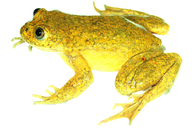|
Telmatobius ventriflavum Catenazzi, Vargas García & Lehr, 2015
Yellow-bellied Water Frog | family: Telmatobiidae genus: Telmatobius |
| Species Description: Catenazzi A, Vargas V, Lehr E 2015 A new species of Telmatobius (Amphibia, Anura,Telmatobiidae) from the Pacific slopes of the Andes, Peru. ZooKeys 480: 81-95 | |
 © 2015 Alessandro Catenazzi (1 of 6) |
|
|
|
Description It has a distinct bright yellow to orange underside, as well as a distinct golden yellow to brown back with uneven dark brown, golden, and red markings. This species is easy to distinguish from other central Peruvian Andean species of Telmatobius with the exception of T. carrillae and T. intermedius by the absence of premaxillary and maxillary teeth. It can be further distinguished from T. carrillae by the presence of vomerine teeth. It can be distinguished from T. intermedius by its larger size, as T. intermedius reaches only 45 mm in snout-vent length in both sexes whereas T. ventriflavum can reach 55.7 mm in females and 48.5 mm in males. It additionally differs from T. intermedius by its flatter head, absence of minute spines on the skin, and the presence of nuptial spines on the backs and sides of the thumb in males. Another similar species, T. peruvianus, differs from T. ventriflavum by the presence of premaxillary teeth, wrinkled skin on the back, minute spines throughout the body, and large scattered nuptial spines on the thumb. Telmatobius rimac differs in its larger body size (snout-vent length is 70.5 mm in males and 86.9 mm in females), a sturdier built body and limbs, a brown underside, and the underside of the limbs being yellow. Males of T. arequipensis differ by the presence of nuptial spines on the first two fingers. Telmatobius jelskii differs in its larger body size (snout-vent length is 68.6 mm in males and 84.7 mm in females), presence of large tapered nuptial spines on the thumbs, minute spines on chest and throat of males, white to light-grey underside, and yellow orange markings on the legs (Catenazzi et al. 2015). In life, the back is golden with spots, especially on the head and shoulders, with markings that range from dark brown, to red, or yellow. The sides are light brown-yellow, and the underside is golden to orange-yellow with faint spots on the chest. The undersides of the limb insertions quickly turn from brown-yellow to orange going away from the center of the body and towards the rear. The iris is light grey and has small black speckling. The eyes are bordered by a slender blue-green ring. In ethanol, the backside of the body is greyish brown, with noticeable dark and light grey spots on the back. The underside is light yellow-grey, and the undersides of the limbs are yellowish brown with yellowish grey markings. The undersides of the hands and feet are grey, and the fingers and toes are cream colored (Catenazzi et al. 2015). Males are smaller than females, though this requires further verification as only one male has been collected for observation. Some individuals have lighter gold/yellow coloring on the back, however most individuals have dark brown, red and yellow spotting on the back. Ventral coloration appears to vary with sex, with males having brighter and more extensive gold and orange coloration on the undersides of their limbs and females having more a subtle coloration similar to the yellow on their throat and abdomen (Catenazzi et al. 2015). Distribution and Habitat Country distribution from AmphibiaWeb's database: Peru
Life History, Abundance, Activity, and Special Behaviors Trends and Threats Relation to Humans Possible reasons for amphibian decline General habitat alteration and loss Comments High morphological variation within individual Telmatobius species has made it difficult to determine the phylogenetic relationships within this genus. This new species is morphologically similar to T. intermedius and T. peruvianus, and also resides in a similar habitat, though no genetic analyses have been done to analyze the relationships of these species (Catenazzi et al. 2015). The specific epithet, ventriflavum, comes from the Latin words venter, meaning belly, and flavus, meaning yellow. This is in reference to the yellow-orange coloration of the underside of the body (Catenazzi et al. 2015).
References
Catenazzi, A., Vargas, V., García, Lehr., E. (2015). ''A new species of Telmatobius (Amphibia, Anura, Telmatobiidae) from the Pacific slopes of the Andes, Peru.'' ZooKeys, 480, 81-95. Originally submitted by: Kendra Ritchie (first posted 2015-09-09) Edited by: Gordon Lau (2015-09-21) Species Account Citation: AmphibiaWeb 2015 Telmatobius ventriflavum: Yellow-bellied Water Frog <https://amphibiaweb.org/species/8304> University of California, Berkeley, CA, USA. Accessed Jan 22, 2025.
Feedback or comments about this page.
Citation: AmphibiaWeb. 2025. <https://amphibiaweb.org> University of California, Berkeley, CA, USA. Accessed 22 Jan 2025. AmphibiaWeb's policy on data use. |


 Map of Life
Map of Life